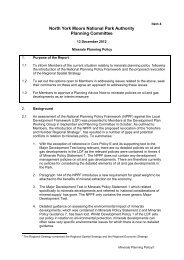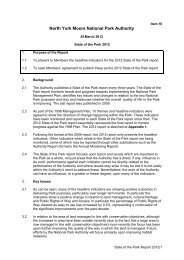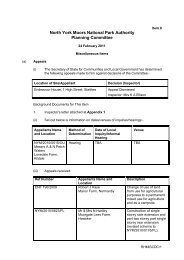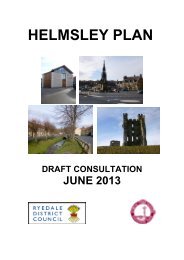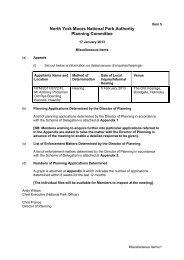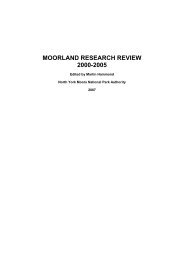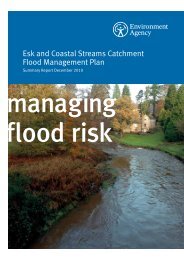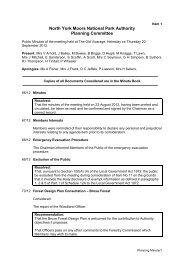Management Plan - North York Moors National Park
Management Plan - North York Moors National Park
Management Plan - North York Moors National Park
You also want an ePaper? Increase the reach of your titles
YUMPU automatically turns print PDFs into web optimized ePapers that Google loves.
Water Framework DirectiveThe Water Framework Directive 5 requires that all water bodiesachieve ‘good’ status by 2015. Although there has been animprovement in the water quality at river monitoring sites overthe lifetime of the current <strong>Management</strong> <strong>Plan</strong> there are stillproblems with diffuse pollution, and many water bodies arefailing due to barriers such as weirs which delay or prevent fishmigration.Food SecurityGreater pressure on land resources and escalating foodprices in recent years has focused attention on the need forsecure food supplies. The need to increase food productionis recognised across Government policy, including in theEngland Biodiversity Strategy 6 . Whilst food production isdriven by global markets it is important that the <strong>Management</strong><strong>Plan</strong> recognises the productive capacity of the <strong>National</strong> <strong>Park</strong>.A study of farming and farm output in the <strong>National</strong> <strong>Park</strong>undertaken by Askham Bryan College 7 provides an importantpiece of evidence for the <strong>Management</strong> <strong>Plan</strong>. One of theissues arising from the report is how to sustain or improvethe productivity of the sector without harming the <strong>National</strong><strong>Park</strong>’s special qualities – it is generally accepted that furtherintensification of agriculture for example through increaseduse of fertilisers and pesticides or more intensive factoryfarming would harm the environment and landscape of the<strong>National</strong> <strong>Park</strong>. However, improved skills and practices couldincrease production and profitability without detracting fromthe area’s special qualities as could increased investment incertain forms of agricultural technology.Tourism and BrandingTourism is important to the economy of the <strong>National</strong> <strong>Park</strong>,bringing in £416 million in 2010. There is a need for a cleareridentity and ‘branding’ of the <strong>North</strong> <strong>York</strong> <strong>Moors</strong> to maintainits attraction as a visitor destination and support the localeconomy. Without a strong brand, locally produced goodswill not flourish and without awareness of the existence of the<strong>National</strong> <strong>Park</strong> the second purpose relating to understandingand enjoyment of its special qualities cannot be achieved.There is evidence that the value of tourism to the localeconomy has declined since 2007 and this <strong>Management</strong><strong>Plan</strong> proposes an increase in visitors and visitor spending inorder to reverse this decline. However, visitor activity needsto be managed to avoid harmful impacts. It is proposed thata new Promoting the <strong>Park</strong> <strong>Plan</strong> to sit alongside the existingRecreation and Access Strategy is developed with policies toachieve these objectives.Upland Economy and Common AgriculturalPolicy ReformThe Government has conducted a policy review of the Englishuplands 8 which emphasises their importance in providingbenefits for society such as food production, floodwaterand carbon storage, provision of drinking water, landscapequality and biodiversity. The review document sets out howDEFRA and its partners will work to support the uplandsand its communities. Payments to farmers and landownersfor the delivery of ecosystem services is also beingresearched by DEFRA.Health through NatureHumans evolved in the natural environment and contactwith nature is fundamental to our physical and mentalwell being. People have come to the <strong>North</strong> <strong>York</strong> <strong>Moors</strong>for over a thousand years for spiritual refreshment andcontemplation. The health benefits of physical activity inreducing levels of obesity and stress are now a major partof the public health agenda compared with ten years ago.In 2009, almost a quarter of adults in the UK were classifiedas obese 9 . Although physical activity levels amongst adultsare increasing, those achieving the recommended amountsare in the minority. Access to outdoor activities and contactwith nature is seen as increasingly important for children.Walking is Britain’s most popular outdoor recreationalactivity and the rights of way network in the <strong>National</strong> <strong>Park</strong>is an important resource to meet this demand. The <strong>National</strong><strong>Park</strong> as a whole provides calm in a busy world and allowspeople to enjoy the non material aspects of life.5 Directive 2000/60/EC6 Biodiversity 2020: A Strategy for England’s wildlife and ecosystemservices (DEFRA, 2011)7 Agricultural Output in the <strong>National</strong> <strong>Park</strong> – Current Level and FutureProspects (Askham Bryan College, 2011)8 Uplands Policy Review (DEFRA, 2011)9 Statistics on obesity, physical activity and diet (Health and SocialCare Information Centre / NHS, February 2009)<strong>North</strong> <strong>York</strong> <strong>Moors</strong> <strong>National</strong> <strong>Park</strong> <strong>Management</strong> <strong>Plan</strong>15




